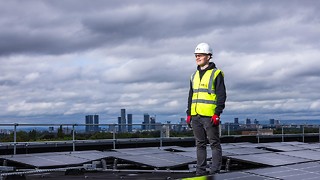Face It: The work of ‘JR’
Broken walls, impoverished towns and world famous art galleries: Louisa Long talks to graffiti artist JR, for whom the world is his canvas
Meeting the mysterious ‘JR’ is not dissimilar to meeting a hyperactive child on Proplus – his energy is relentless and it is impossible not to be swept up by his enthusiasm for his work. And this is no criticism. Without this dynamo character, JR wouldn’t be who he is today: a 27-year old internationally renowned Franco-Tunisian photographer, whose work has been displayed at the Venice Biennale, the Tate Modern, and of course any public surface he chooses. For the self-proclaimed “photograffeur”, his projects have taken him from the troubled banlieues of Paris to the Israeli-Palestinian border, where he stays for long periods of time organising and realising his ideas.

The principle of JR’s work is to take portraits of people living in areas of political conflict or extreme poverty and blow them up to mammoth proportions. He then plasters them over the walls, steps, and roofs of the community in question. By putting these images in places where passers-by can’t fail to notice them, JR forces the viewer to confront the reality of the people behind the image. We are obliged to acknowledge that ordinary people, not unlike ourselves, can find themselves in difficult situations. He explains, “my photos invite people, both the people in the photographs and other people, to look at the world in a different way”.
But JR is clear that his work is not politically engaged, at least not directly. His intentions are “artistic, not political”, he tells me. “I’m not a humanitarian. I’m not trying to change the political situation in these places”. Despite assuming the detached role of documentary-maker, his striking images can’t help but arouse the attention of politicians, the media, and the general public. Attention that JR certainly wouldn’t want to discourage. In choosing the West bank wall between Israel and Palestine for one of his first international projects, JR can hardly have expected a neutral response.
His career began 12 years ago when he picked up an abandoned camera on the Paris metro, and began taking photos of his friends graffitiing the buildings of the city’s notoriously destitute suburbs. It wasn’t long before he was fly-posting his photos of grimacing faces all over the capital. He also took photos of middle class Parisians staring in disbelief at the ridiculous expressions that had invaded their streets, “as if” he says, “they were looking at the moon”.

Despite never having had a photography lesson, JR has gone on to meet with huge success. In October of last year he was awarded the TED (Technology Entertainment and Design) prize. The prize, previously awarded to the likes of Bono and Jamie Oliver, is for humanitarian work. Whether or not JR agrees with this assessment of his art, he will soon have to decide to which charity he will donate the money raised for him by the organisation.
Never resting on his laurels, he has recently made the feature-length documentary, “Women are Heroes”, released in France last week. Shot by two British filmmakers, Dan Lowe and Anthony Dickenson, the film documents a tour he began in 2008 to the vibrant favelas in Rio de Janeiro and the impoverished slums of Kenya, Cambodia and India. In these places he gradually formed a relationship with locals, recording their lives by interviewing and photographing them.
He chose to focus on women because he found that it was often courageous, resilient, self-effacing female figures that were the faces behind conflict or poverty. Their stories, while distressing, are nonetheless uplifting; these women do not want to be pitied. “Looking into their eyes, you see that they are not just victims but survivors.” By blowing their images up to the size of advertisements, JR presents them as celebrities, showing that no heights should be considered beyond their reach. Indeed, he is adamant, “I am not the star of my work. The subjects of my photographs are the stars of my work.”
The film got rave reviews from all but one of France national papers, Le Monde, which dismissed JR as “self-celebrating” and lacking sincere interest in the lives of the women he interviewed. It is true that at times the scenes of locals explaining why JR’s work is so remarkable were a little hard to swallow. But in the main the film was an unbiased explanation of the aims behind his work. Yesterday he defended himself, asserting, “the film is not about me at all. It is about the women in the photographs”.
Beyond the question of their political contribution, JR’s stark and monumental work is remarkable on an aesthetic level. And although many of his posters have been left to disintegrate over time, this process has become a part of their appeal as the images become inseparable from their surroundings.
With “Women are Heroes” out in cinemas this week, JR has already begun working on a new project called “Wrinkles of the City”. “The idea”, he explains, “is to contrast the age and tradition of the city with its extraordinary speed of new development.” Despite his arrest in Shanghai for working on this project, JR seems undeterred. He promises that he has plenty more projects up his sleeve. Perhaps it won’t belong before he pops up on a wall near you.
 News / Uni offers students £55k in payouts31 October 2025
News / Uni offers students £55k in payouts31 October 2025 News / Uni error forces deeper spending cuts31 October 2025
News / Uni error forces deeper spending cuts31 October 2025 News / Students launch women’s society excluding trans women31 October 2025
News / Students launch women’s society excluding trans women31 October 2025 News / Students allowed to use AI, says new uni guidance31 October 2025
News / Students allowed to use AI, says new uni guidance31 October 2025 News / College rowing captains narrowly vote to exclude trans women31 October 2025
News / College rowing captains narrowly vote to exclude trans women31 October 2025









